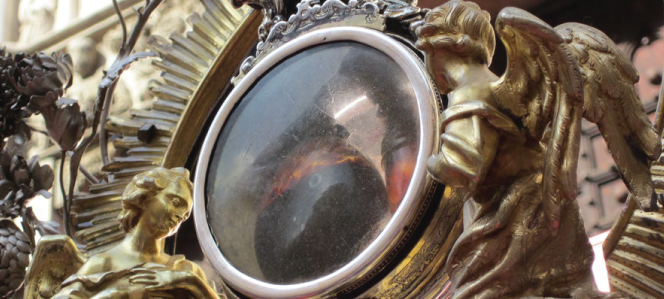If you think Catholicism is a little weird, then you’re in for a real treat. Today the Church celebrates St. Januarius, the patron saint of Naples and of blood banks, and his strange story is one of the best.
Januarius, affectionately known as San Gennaro, was the bishop of Benevento. Along with his six companions – Festus, Desiderius, Sossus, Proculus, Euticius, and Acutius – Januarius was arrested during the Christian persecution of Diocletian in 305. The young bishop and his faithful friends were thrown to the lions, but the beasts weren’t hungry. The felines wouldn’t touch the seven men. (I often wonder how the soldiers and the crowds responded when this sort of thing happened. Did they yell at the lions? “Eat! Eat those awful Christians! Come on, they taste so good!” Or did some of them get scared and sense that these Christians might really be onto something?) Eventually, the soldiers decided to simply kill the men themselves. They chopped off their heads.
Now here’s where things get interesting. Christians, because of their belief in the resurrection of the body, go to great lengths to assure the proper burial of a body. Just as Joseph of Arimathea asked for Jesus’ body after his death on the cross, some of the faithful would have requested the bodies (and heads) of Januarius and his six companions. Someone who was part of that group decided to collect some of Januarius’ blood. The martyr’s blood was transferred into an ampoule – a small glass vial used to preserve a liquid – which made its way to Naples. The bishop’s bones are buried in the crypt of the cathedral. The ampoule still contains some of his dried blood.
A few times a year, the ampoule of dried blood is shown to the public – today, the feast of St. Januarius, is one of those days. The Archbishop of Naples processes with the relic around the cathedral, the faithful pray intensely, and then it happens. Januarius’ dried blood begins to liquefy and bubble as the ancient relic is shown to the people of God.
I know, I know – it’s weird. Indeed it is. And it’s been happening for over 400 years. I’ve never been to Naples to see it, but thousands of other people have. Experiments have been conducted, yet there has been no medical or scientific explanation for this strange phenomenon. The brilliant Cardinal Newman said, “I think it impossible to withstand the evidence which is brought for the liquefaction of the blood of St. Januarius at Naples.”
What do we make of this strange happening? Do we dismiss it as a magic trick? Do we book a ticket to Naples? Do we simply roll our eyes and say, “There’s another reason that I no longer go to church.” Or do we go to church this Sunday, for the first time in a long time, because of this miraculous story?
Jesus said that we would know a tree by its fruits. When it comes to miraculous stories like the one of Januarius’ blood, it’s best to look at the lives of the faithful. Does this strange phenomenon bring people to deeper conversion? Are they more in love with Jesus and his Church because of it? After viewing the ancient bubbling blood, are the witnesses more charitable, just, prudent, chaste, kind, and merciful? Are those witnesses inspired to become witnesses – literally, martyrs – themselves?
For over 400 years folks have found a deeper faith in Christ and his Church because of the blood of Januarius. Some have even turned to Jesus for the first time because of it. Repentance, conversion, and discipleship are, no doubt, good fruits.
Tertullian said, “The blood of the martyrs is the seed of the church.” Sometimes, that blood is bubbling.
